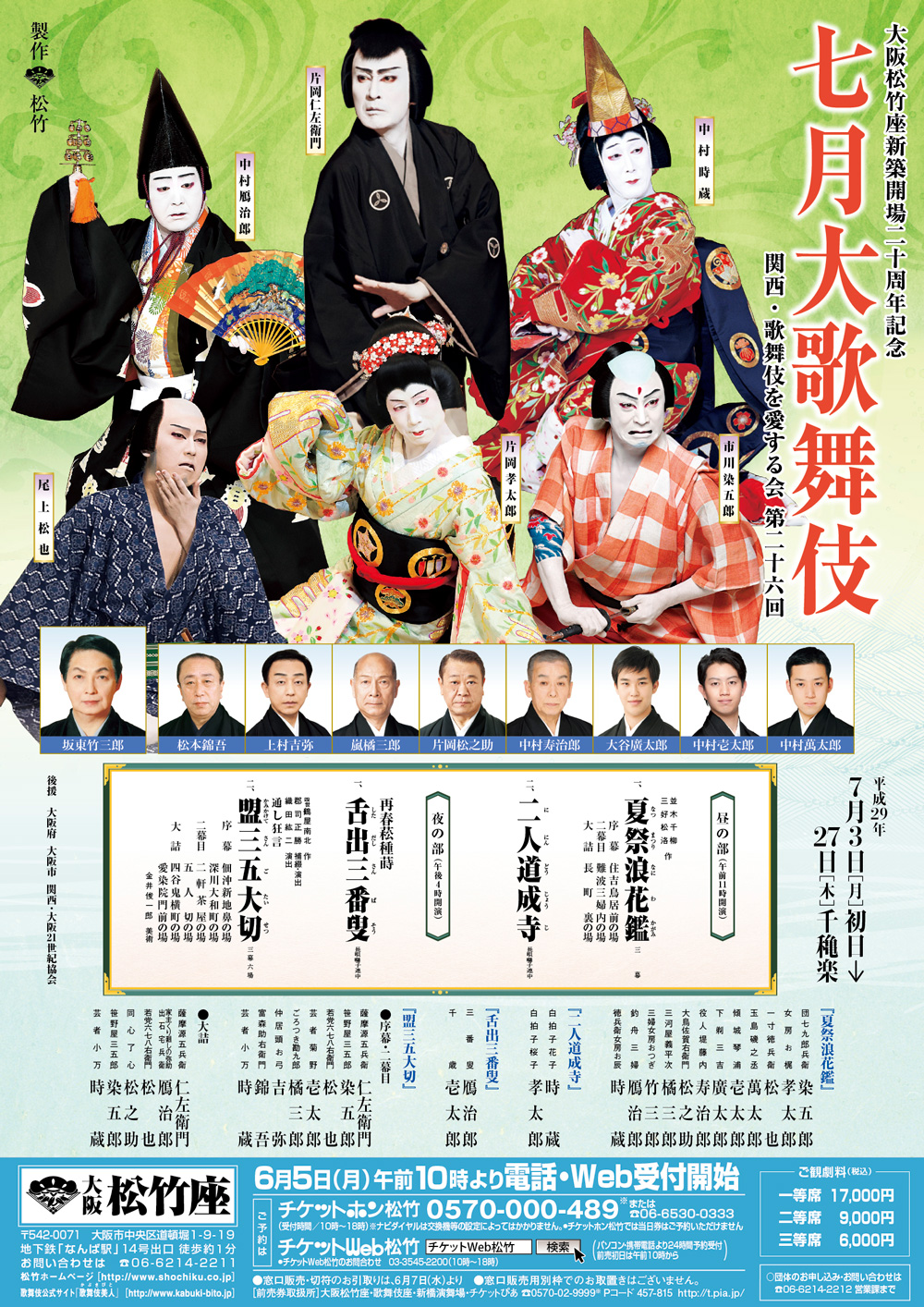Osaka Shochikuza Theatre
July at the Osaka Shochikuza Theatre
Daily: Jul 03 (Mon) - Jul 27 (Thu), 2017
Matinee:11:00 AM
Evening Show: 4:00 PM
Time Schedule
On sale: from Jun 05 (Mon), 2017 10:00AM(JST)
First Class: 17,000- / Second Class: 9,000- / Third Class: 6,000-
Unit: Japanese Yen (tax included)
Osaka Shochikuza Theatre (at OSAKA) Theatre Information
- Book Ticket
- Single Act Tickets
- *No English supporting Guide available.
This month's performances commemorate the twentieth anniversary of the reconstruction of the Osaka Shochikuza Theatre. You can see masterpieces from the kabuki classics as well as dances performed by a splendid cast ranging from young stars to top-rated actors. In the evening show, one of kabuki's top actors, Kataoka Nizaemon, will be performing one of his most successful roles, Satsuma Gengobē from 'Kamikakete Sango Taisetsu'
NATSU MATSURI NANIWA KAGAMI
[The Summer Festival in Old Ōsaka]
CAST :
- Danshichi Kurobē
- Ichikawa Somegorō
- Issun Tokubē
- Onoe Matsuya
- Okaji, Danshichi's wife
- Kataoka Takatarō
- Tsuribune Sabu
- Nakamura Ganjirō
- Otatsu, Kurobē's wife
- Nakamura Tokizō
STORY :
This is a sewamono play, a work portraying in a realistic way the lives of ordinary people in the Edo period.
This popular play shows the pride and sense of honor among commoners in old Ōsaka. Danshichi, a gallant fishmonger, does everything he can to protect the weak young son of his patron. He is aided by his companion Tokubē and an older man named Sabu. Even Tokubē's wife heroically helps out, but in the end, Danshichi is betrayed by his evil father-in-law Giheiji. In the famous climax of the play, Danshichi is forced to kill Giheiji as he struggles with him in a mud-covered field down in a lonely alley, as we hear in the background the shouts of local festival-goers nearby. Danshichi divorces his wife and parts with his family so that they will not be punished with him. Tokubē suggests that Danshichi flee with him as they are surrounded by the arresting officials.
NININ DŌJŌJI
[Two Women at Dōjōji Temple]
CAST :
- Hanako, a shirabyōshi dancer
- Nakamura Tokizō
- Sakurako, a shirabyōshi dancer
- Kataoka Takatarō
STORY :
This dance is a special double version of "Kyōkanoko Musume Dōjōji", a masterpiece for 'onnagata' female role specialists.
Two 'Shirabyōshi' court dancers who name themselves Hanko and Sakurako visit Dōjōji Temple in spring in full bloom. They perform various dances such as a dance with a golden crown in Nō style, a dance holding no objects, a flower-hat dance and so on glamorously in the presence of priests.
SHITA DASHI SANBASŌ
[The Sanbasō with his Tongue Sticking Out]
CAST :
- Sambasō
- Nakamura Ganjirō
STORY :
Based on the ritual performance named Okina in the Nō theater, Sanbasō is a vigorous dance that is also an important prayer for prosperity. This particular version takes its title from the fact that the character called Sanbasō actually sticks his tongue out while he dances. Some say that he does this out of being absorbed by the joy of his dance. Others say that this is an auspicious sign. In any case, this energetic and joyful dance is exhilarating to watch and is a perfect addition to this auspicious program.
KAMIKAKETE SANGO TAISETSU
[Koman and Gengobē]
CAST :
<Act I and Act II>
- Satsuma Gengobē
- Kataoka Nizaemon
- Sasanoya Sangorō
- Ichikawa Somegorō
- Rokushichihachiemon
- Onoe Matsuya
- Koman, a geisha
- Nakamura Tokizō
<Act III>
- Satsuma Gengobē
- Kataoka Nizaemon
- Kurimawashi no Yasuke, a landlord/Izushi Takubē
- Nakamura Ganjirō
- Rokushichihachiemon
- Onoe Matsuya
- Sasanoya Sangorō
- Ichikawa Somegorō
- Koman, a geisha
- Nakamura Tokizō
STORY :
This is a sewamono play, a work portraying in a realistic way the lives of ordinary people in the Edo period.
After writing the most famous ghost play in kabuki, 'The Ghost Stories of Yotsuya' in 1825, Tsuruya Nanboku IV (1755-1829) followed it with Kamikakete Sango Taisetsu. This play is a blend of the famous Chūshingura, with its tangled stories of loyalty among the masterless samurai who ultimately avenge their master's death, and the story of another play, Godairiki, about the love between a geisha named Koman and the samurai Satsuma Gengobē. Their love is spoiled by the jealousy of a man named Sangorō. Nanboku also added a touch of humor with a haunted house which is supposed to be the original one that Nanboku made famous with his 'Ghost Stories of Yotsuya'.
Sasano Sangorō is married to Koman, but she has become a geisha to help him raise the money he needs to help his lord, a man that he has never seen. In the pleasure quarters, the samurai Satsuma Gengobē falls in love with her and spends huge sums of money on her, despite the fact that he needs money for the sake of the Chūshingura vendetta. Finally, Gengobē gets money and Sangorō and Koman decide to defraud him of it, which results in a massacre in the pleasure quarters. Ironically, Gengobē is none other than the unknown master for whom Sangorō was trying to raise money. This story of passion and greed takes place against the background of inexplicable fate and the strict requirements of samurai society and adds ample doses of sardonic humor, a perfect play for our times.


